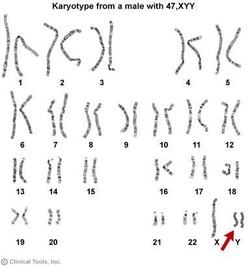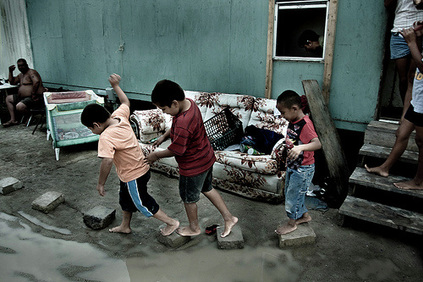Nature Vs. Nurture Debate
Crime

Where did he go wrong?
The debate has caused much controversy in justifying human characteristics. It has even been used in courts to defend criminal behavior.
Nature
Sex Chromosomes

An explanation to help possibly explain the inherent criminal nature of particular individuals is their sex chromosomal diseases. It is believed that the XYY Syndrome and criminality share a correlation.
The chromosomal mapping constituting XYY is an additional Y chromosome in Pair 23; an additional chromosome determining the maleness of an individual. The logic behind this argument relies on the popular belief that males are commonly associated with aggresive behavior and delinquency. It is reasoned that the extra male chromosome induces higher levels of testosterone. The criminality of the mutated individual is therefore a result (Does A Criminal Gene Exist).
This reasoning came to the attention of the public when in 1966, a man was convicted of rape and murder of eight students. When tried, the defense attorney pleaded to excuse the person because he was suffering from XYY Syndrome. Despite this argument, he was sentenced to death. It was later discovered the man actually had a normal genotype.
The consequence of such an event sparked controversy over the insensitivity and generally inaccurate application of the genetic disease in courts. Additionally, Harvard researchers began screening newborns and monitoring those with the syndrome. They eventually came to the conclusion that males with the XYY genotype were overrepresented in the criminal demographic (The XYY Genotype and Male Criminality).
The chromosomal mapping constituting XYY is an additional Y chromosome in Pair 23; an additional chromosome determining the maleness of an individual. The logic behind this argument relies on the popular belief that males are commonly associated with aggresive behavior and delinquency. It is reasoned that the extra male chromosome induces higher levels of testosterone. The criminality of the mutated individual is therefore a result (Does A Criminal Gene Exist).
This reasoning came to the attention of the public when in 1966, a man was convicted of rape and murder of eight students. When tried, the defense attorney pleaded to excuse the person because he was suffering from XYY Syndrome. Despite this argument, he was sentenced to death. It was later discovered the man actually had a normal genotype.
The consequence of such an event sparked controversy over the insensitivity and generally inaccurate application of the genetic disease in courts. Additionally, Harvard researchers began screening newborns and monitoring those with the syndrome. They eventually came to the conclusion that males with the XYY genotype were overrepresented in the criminal demographic (The XYY Genotype and Male Criminality).
Nurture
Honor Among Thieves

Are these children destined to become criminals due to their ethnic and economic status?
Despite the evidence that genetics and biology create the criminal in a person, the fact that not every criminal has a disease or disorder gives ground for the nurture side of the debate to stand on.
In fact, a study conducted on a crime family succeeds in refuting the notion that nature dictates the criminality of an individual. A New York family, falsely named the Jukes family to protect their identity, exhibited criminal behavior in its 709 members. When factors separated the outer branches from the core, 120 persons grew up to become criminals, in spite of the fact these family members were not blood-related. To further support the nurture side of the debate, these family members remained in contact with the core family (Nicolle).
Research conducted between 1996 and 2003 explains that a number of factors may have contributed to a life of crime in individuals. These factors are generally identified as poverty, poor education, parental involvement, and large family structure (Genes, Environment, and Criminal Behavior).
It's difficult to label whether or not the effects of this research are consequences or successes because of how prisons have adapted suit its inmates. Rules are enforced more strictly to replace the lawless upbringing of the prisoners, and at the same time, more facilities have become available to inmates so they can educate themselves and know some of the luxuries that were previously absent in their lives.
In fact, a study conducted on a crime family succeeds in refuting the notion that nature dictates the criminality of an individual. A New York family, falsely named the Jukes family to protect their identity, exhibited criminal behavior in its 709 members. When factors separated the outer branches from the core, 120 persons grew up to become criminals, in spite of the fact these family members were not blood-related. To further support the nurture side of the debate, these family members remained in contact with the core family (Nicolle).
Research conducted between 1996 and 2003 explains that a number of factors may have contributed to a life of crime in individuals. These factors are generally identified as poverty, poor education, parental involvement, and large family structure (Genes, Environment, and Criminal Behavior).
It's difficult to label whether or not the effects of this research are consequences or successes because of how prisons have adapted suit its inmates. Rules are enforced more strictly to replace the lawless upbringing of the prisoners, and at the same time, more facilities have become available to inmates so they can educate themselves and know some of the luxuries that were previously absent in their lives.
